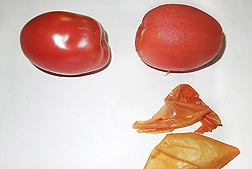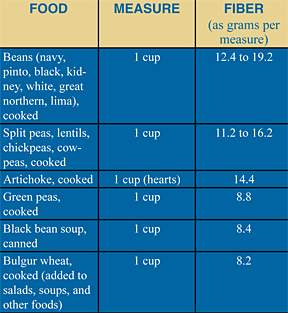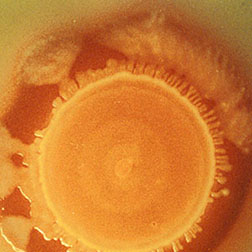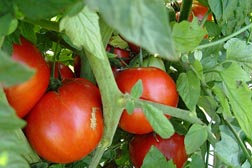This page has been archived and is being provided for reference purposes only. The page is no longer being updated, and therefore, links on the page may be invalid.
Food and Nutrition Research Briefs, July 2015
| July 2015 |
Infrared-Based Peeling of Tomatoes May Improve Precision, Save WaterAgricultural Research Service, industry and university scientists have recently patented a process for using infrared heating to simplify removal of tomatoes’ tight-fitting peels, which may offer advantages over other peeling technologies. For example, infrared-based peeling is mostly waterless and might also reduce the expense of recycling the water that is used or the proper disposal of it. That’s a benefit for canneries in sometimes drought-stricken California, the state that produces the majority of the nation’s processing tomatoes. What’s more, the infrared process may help reduce wasteful "overpeeling" of tomatoes that can occur when too many layers of tomato are inadvertently removed along with the peel. For details, contact: Zhongli Pan, (510) 559-5861, Healthy Processed Foods Research Unit, Western Regional Research Center, Albany, California. |
|
|
Natural Enzyme Examined as Antibiotics AlternativeLysozyme, a naturally occurring antimicrobial enzyme, is used in food and beverage applications such as cheese- and wine-making. Now, it may also prove useful as an antibiotic alternative for improved feed efficiency and growth in pigs, according to studies by Agricultural Research Service scientists. In a recently published trial, the researchers compared the growth rates and weight gains of two groups of 600 piglets placed on one of three diet regimens: a standard feed regimen of corn/soybean meal and specialty protein, a second regimen of the same with lysozyme added, and a third containing the antibiotics chlortetracycline and tiamulin hydrogen fumarate rather than lysozyme. Piglets on lysozyme- or antibiotics-treated feeds grew approximately 12 percent faster than untreated pigs—even in uncleaned pens, suggesting that the treatments successfully ameliorated the effects of indirect immune challenge. For details, contact: William Thomas Oliver, (402) 762-4206, Nutrition and Environmental Management Research Unit, U.S. Meat Animal Research Center, Clay Center, Nebraska. |
|
|
New Tracking Tool for Pathogen InvestigatorsA cost-effective diagnostic tool and dataset for identifying various strains of Salmonella has been developed by an Agricultural Research Service scientist. The tool, called Intergenic Sequence Ribotyping (ISR), is helping improve poultry production and human health internationally, because it helps control Salmonella in the field and in consumer poultry products. The traditional method, called Kauffmann-White, or KW, is expensive and identifies a particular serotype in only 80 percent of cases. ISR is being used to serotype strains within a particularly virulent group called Salmonella enterica, which is the type associated with foodborne illness. ISR technology is available to specialized laboratories, producers or other qualified users who sign a proprietary Material Transfer Agreement. For details, contact:Jean Guard, (706) 546-3446, Egg Safety and Quality Unit, U.S. National Poultry Research Center, Athens, Georgia. |
Slavin Delivers ARS 2015 W.O. Atwater Memorial Lecture at Experimental Biology"Food is not a talisman: Reflections on the science and practice of nutrition," was the title of Joanne L. Slavin's 2015 W.O. Atwater Memorial Lecture, delivered at the Experimental Biology meeting in Boston. Slavin is an internationally renowned expert on the role of fiber and whole grains in the diet and their bearing on human health. She is currently a professor in the Department of Food Science and Nutrition at the University of Minnesota. The W.O. Atwater Memorial Lecture was established by Agricultural Research Service in 1968 to honor the memory of Wilbur Olin Atwater (1844-1907) and to recognize scientists who have made unique contributions toward improving the diet and nutrition of people around the world. Atwater, considered the father of modern nutrition research and education, was USDA’s first chief of nutrition investigations. Slavin summed up her presentation by mentioning that current obsessions on nutritional bad guys—saturated fat, sodium and added sugar—have left the science arena. She added that nutritional guidance must be based on strong science or the public is misled with hollow promises of the magical properties of foods. For details, contact: Joanne Slavin, (612) 624-7234, Department of Food Science and Nutrition, University of Minnesota, St. Paul, Minnesota. |
|
|
|
Recipe for Flavorful Tomatoes: Heat Before ChillingTomatoes are often picked green and then stored at low temperatures to slow ripening during and after transport. They are then ripened at about 68 °F before being placed on store shelves. That process makes them easier to ship and extends their shelf life but could be the reason why "supermarket tomatoes" often taste bland. An Agricultural Research Service chemist found a five-minute heat treatment before chilling stemmed the loss of several flavor volatiles known to give fruity and floral scents to foods, and treated tomatoes had more flavor than tomatoes that were only chilled. For details, contact: Jinhe Bai, (772) 462-5880, Citrus and Other Subtropical Products Research, U.S. Horticultural Research Laboratory, Fort Pierce, Florida. |
A New Spanish Peanut Variety for Consumers, GrowersA new Spanish peanut variety that packs high levels of healthful oleic acid has been released by Agricultural Research Service scientists and university cooperators. The new variety, called OLé, could provide producers and consumers with a peanut that has heart-healthy qualities as well as disease resistance and longer shelf life. Oleic acid is a beneficial monounsaturated fatty acid, and the high oleic acid levels in the peanut make its oil a heart-healthy one for consumers. Growers like the new variety because of its disease resistance and potential for high yield and grade. For details, contact: Kelly D. Chamberlin, (405) 624-4141 ext. 225, Wheat, Peanut and Other Field Crops Research Unit, Stillwater, Oklahoma. |
|
|
|
Wheat Varieties Make Way to Breads and Malt BeveragesTwo varieties of wheat, released for production in 2009 by a group led by an Agricultural Research Service scientist, have now become valued ingredients in products of two North Carolina businesses. Appalachian White and NuEast are being used in bread and beer. NuEast is a hard red winter wheat and Appalachian White is a hard white winter wheat. Some businesses in North Carolina are now using the wheat varieties in some of their products. ARS has a long-running project with Carolina Ground, an artisan mill and bakery in Asheville, North Carolina. The bakery uses Appalachian White and NuEast in their artisan flours and baking recipes. Riverbend Malt House—the first malt house in the eastern United States—makes their wheat malt mainly from Appalachian White wheat. For details, contact: David S. Marshall, (919) 515-6819), Plant Science Research Unit, Raleigh, North Carolina. |
New Berries from ARSTwo new berries have been developed by Agricultural Research Service researchers and their collaborators. Sweet Sunrise (U.S. PP 25,223) is a new high-yielding strawberry cultivar that ripens in June. It produces large, firm attractive fruit having excellent quality. Yields are comparable to, or higher than, those of other recent releases such as Charm, Valley Red and Sweet Bliss or the industry standards Tillamook, Totem and Hood. They also developed Columbia Star (U.S. patent applied for), a thornless, trailing blackberry cultivar from the same breeding program as Sweet Sunrise. It is a high-quality, high-yielding, machine-harvestable blackberry with firm, sweet fruit that when processed is similar in quality to, or better than, fruit from the industry standards Marion and Black Diamond. Both of these new berry cultivars will be good additions to the fresh- and processed-fruit markets. For details, contact: Chad Finn, (541) 738-4037, Horticultural Crops Research Unit, Corvallis, Oregon. |
|












